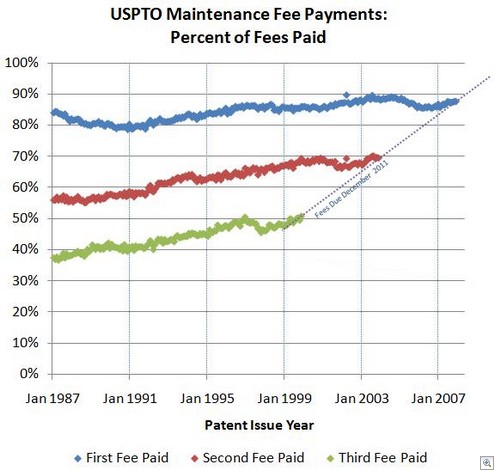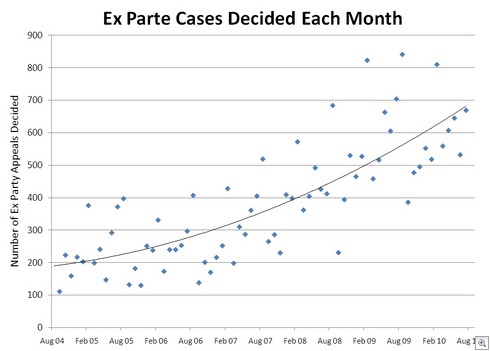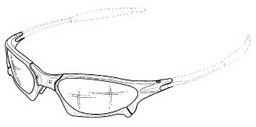The following guest post by Professor Paul Janicke ties-in with his new article published at: Paul M. Janicke, The Imminent Outpouring from the Eastern District of Texas, 2017 Patently-O Patent Law Journal 1. – DC
by Paul M. Janicke┼
When the Supreme Court reverses the Federal Circuit’s venue ruling in the TC Heartland case, a reversal widely expected, it will return patent venue to the time prior to 1988, when the residence of a corporation for patent venue purpose was limited to (i) a district within the state of incorporation, or (ii) a district where the corporation has a regular and established place of business and has allegedly committed an act of infringement. Presently pending in the Eastern District of Texas are 1,000+ patent cases. The number may go up or down a little before the Court’s ruling, but it’s not likely to change much in that short time.[1] My inquiry is: What will happen to those cases? My analysis on this subject can be found at Paul M. Janicke, The Imminent Outpouring from the Eastern District of Texas, 2017 Patently-O Patent Law Journal 1..
The new venue statute upon which the Court will base its ruling became effective in January 2012. That means it applies to nearly all the cases now on the Eastern District’s docket, and the venue for hundreds of those cases was likely improper. Those defendants who are not Texas corporations and who lacked any regular and established place of business in Eastern Texas when suit was filed will be entitled to dismissal or transfer to a district that would have been proper under the new law, unless they have waived the improper venue defense. Let’s take a look at the groups of possibly affected defendants.
Local Merchants
Some defendants are local merchants in the Eastern District, accused of infringement only because they sell products made by others. Venue as to these merchants will be proper under either the old or new venue rules, so they are entitled to neither dismissal nor transfer. If the case against a merchant’s vendor is transferred, the merchant’s best bet is to seek a stay of the case against it. While stays are not particularly favored in the Eastern District, a situation like the present one has not likely been encountered before. It may work.
Active Players As Defendants
These are typically manufacturers of high-tech products or vendors of software. Computer-related technology is said to be the subject of over 90% of patent case filings in the district. Most of them lack any regular place of business in Eastern Texas, although we have found some 70 companies who employ 100 or more persons in the district and are defendants in pending patent cases there. Most of these businesses are in Plano, with a few in Beaumont. They too will have to stay put. It isn’t required that the place of business be related to the accused infringing activity.
The Many Other Defendants, And the Problem of Waiver
Those companies lacking a regular business location in the Eastern District will, for the most part, want to exit that district. Some may choose to stay there in order to effect a quick settlement or to show support for their beleaguered customers who have been sued in the district, but I estimate at least 800 will consider seeking a transfer. These break down into two roughly equal groups, those who have waived improper venue and those who have not. Waiver of this defense most typically occurs by failure to plead it in the answer or in an early motion under Rule 12. A sampling of pleadings in pending Eastern District patent cases reveals that in roughly 400 cases the main defendant did not plead improper venue or make a Rule 12 motion. (Note that this is a different subject from inconvenient venue, which is handled under a different statutory section and was sometimes pleaded in the answers.) It is understandable why the improper venue pleading was missing in so many cases: No one knew or even suspected until very recently that the venue rules had been changed by Congress in 2011, effective for all cases filed after January 2012. Good ethical lawyers know they shouldn’t plead a matter for which they have no legal or factual basis, and so they didn’t, and therein lies the waiver. Unfortunately, they cannot undo it by arguing “change in the law.” The change occurred in 2012.
The other group of defendants may have been insightful, but more likely were just following a form-book shotgun answer, and so they did plead improper venue in their answers. Answering this way is usually enough to preserve this defense, but not always. It has been held that taking discovery does not trigger a waiver, nor does proceeding to trial. It is thought that the corporate defendant who has pleaded the defense unsuccessfully has been forced to remain in the improper forum, so these litigation activities are not held against it. However, some courts have held that moving for summary judgment (unsuccessfully of course) is a different matter and does cause a waiver. You are not obliged to seek summary judgment, and you are invoking the court’s power. So some in the second group may find they too have waived.
For Those Exiting, Where Will They Be Sent?
This leaves about 400 non-waived cases. The case law on improper venue cases shows a distinct judicial preference for transfers rather than dismissals. To what districts will these non-waived defendants be transferred? Whatever districts are chosen, we should bear in mind that some of the NPE plaintiffs may not wish to follow, due to the expense involved, so those cases may effectively end. For more serious plaintiffs, we do not know where the cases will go. It depends on subjective factors applicable to each case, but here are some possible options: (1) Choose a district that one or both parties ask for. (2) Select a proper district that has a number of patent pilot judges, the three largest being Northern Illinois, Southern New York, and Central California. (3) Use history as a guide: In 1997, one year before the large influx to Eastern Texas began, the busiest patent districts were Northern California (172 filings), Central California (162 filings), and Northern Illinois (116 filings). In that year the number of patent cases filed in the Eastern District of Texas was: 10. We shall soon see.
= = = = =
┼ Professor of Law, University of Houston Law Center
[1] The case is set for argument March 27, with a decision very likely before the end of the Court’s term in June.
= = = = =
Read the Article: Janicke.2017.Venue
Prior Patently-O Patent L.J. Articles:
- Mark A. Lemley, Erik Oliver, Kent Richardson, James Yoon, & Michael Costa, Patent Purchases and Litigation Outcomes, 2016 Patently-O Patent Law Journal 15 (Lemley.2016.PatentMarket)
- Bernard Chao and Amy Mapes, An Early Look at Mayo’s Impact on Personalized Medicine, 2016 Patently-O Patent Law Journal 10 (Chao.2016.PersonalizedMedicine)
- James E. Daily, An Empirical Analysis of Some Proponents and Opponents of Patent Reform, 2016 Patently-O Patent Law Journal 1. (Daily.2016.Professors)
- Tristan Gray–Le Coz and Charles Duan, Apply It to the USPTO: Review of the Implementation of Alice v. CLS Bank in Patent Examination, 2014 Patently-O Patent Law Journal 1. (GrayLeCozDuan)
- Robert L. Stoll, Maintaining Post-Grant Review Estoppel in the America Invents Act: A Call for Legislative Restraint, 2012 Patently-O Patent Law Journal 1 (Stoll.2012.estoppel.pdf)
- Paul Morgan, The Ambiguity in Section 102(a)(1) of the Leahy-Smith America Invents Act, 2011 Patently-O Patent Law Journal 29. (Morgan.2011.AIAAmbiguities)
- Joshua D. Sarnoff, Derivation and Prior Art Problems with the New Patent Act, 2011 Patently-O Patent Law Journal 12 (sarnoff.2011.derivation.pdf)
- Bernard Chao, Not So Confidential: A Call for Restraint in Sealing Court Records, 2011 Patently-O Patent Patent Law Journal 6 (chao.sealedrecords.pdf)
- Benjamin Levi and Rodney R. Sweetland, The Federal Trade Commission’s (FTC) Recommendations to the International Trade Commission (ITC): Unsound, Unmeasured, and Unauthoritative, 2011 Patently-O Patent Law Journal 1 (levi.ftcunsound.pdf)
- Kevin Emerson Collins, An Initial Comment on King Pharmaceuticals: The Printed Matter Doctrine as a Structural Doctrine and Its Implications for Prometheus Laboratories, 2010 Patently-O Patent Law Journal 111 (Collins.KingPharma.pdf)
- Robert A. Matthews, Jr., When Multiple Plaintiffs/Relators Sue for the Same Act of Patent False Marking, 2010 Patently-O Patent Law Journal 95 (matthews.falsemarking.pdf)
- Kristen Osenga, The Patent Office’s Fast Track Will Not Take Us in the Right Direction, 2010 Patently-O Patent L.J. 89 (Osenga.pdf)
- Peter S. Menell, The International Trade Commission’s Section 337 Authority, 2010 Patently-O Patent L.J. 79
- Donald S. Chisum, Written Description of the Invention: Ariad (2010) and the Overlooked Invention Priority Principle, 2010 Patently‐O Patent L.J. 72
- Kevin Collins, An Initial Comment on Ariad: Written Description and the Baseline of Patent Protection for After-Arising Technology, 2010 Patently-O Patent L.J. 24
- Etan Chatlynne, Investigating Patent Law’s Presumption of Validity—An Empirical Analysis, 2010 Patently-O Patent L.J. 37
- Michael Kasdan and Joseph Casino, Federal Courts Closely Scrutinizing and Slashing Patent Damage Awards, 2010 Patently-O Patent L.J. 24 (Kasdan.Casino.Damages)
- Dennis Crouch, Broadening Federal Circuit Jurisprudence: Moving Beyond Federal Circuit Patent Cases, 2010 Patently-O Patent L.J. 19 (2010)
- Edward Reines and Nathan Greenblatt, Interlocutory Appeals of Claim Construction in the Patent Reform Act of 2009, Part II, 2010 Patently‐O Patent L.J. 7 (2010) (Reines.2010)
- Gregory P. Landis & Loria B. Yeadon, Selecting the Next Nominee for the Federal Circuit: Patently Obvious to Consider Diversity, 2010 Patently-O Patent L.J. 1 (2010) (Nominee Diversity)
- Paul Cole, Patentability of Computer Software As Such, 2008 Patently-O Patent L.J. 1. (Cole.pdf)
- John F. Duffy, The Death of Google’s Patents, 2008 Patently O-Pat. L.J. ___ (googlepatents101.pdf)
- Mark R. Patterson, Reestablishing the Doctrine of Patent Exhaustion, 2007 Patently-O Patent L.J. 38
- Arti K. Rai, The GSK Case: An Administrative Perspective, 2007 Patently-O Patent L.J. 36
- Joshua D. Sarnoff, BIO v. DC and the New Need to Eliminate Federal Patent Law Preemption of State and Local Price and Product Regulation, 2007 Patently-O Patent L.J. 30 (Download Sarnoff.BIO.pdf)
- John F. Duffy, Are Administrative Patent Judges Unconstitutional?, 2007 Patently-O Patent L.J. 21. (Duffy.BPAI.pdf)
- Joseph Casino and Michael Kasdan, In re Seagate Technology: Willfulness and Waiver, a Summary and a Proposal, 2007 Patently-O Patent L.J. 1 (Casino-Seagate)


 But I put this: Is it reasonable to make a man feel as if, in inventing an ingenious improvement meant to do good, he had done something wrong? How else can a man feel, when he is met by such difficulties at every turn? All inventors taking out a Patent MUST feel so. And look at the expense. How hard on me, and how hard on the country if there's any merit in me (and my invention is took up now, I am thankful to say, and doing well), to put me to all that expense before I can move a finger! Make the addition yourself, and it'll come to ninety-six pound, seven, and eightpence. No more, and no less. . . .
But I put this: Is it reasonable to make a man feel as if, in inventing an ingenious improvement meant to do good, he had done something wrong? How else can a man feel, when he is met by such difficulties at every turn? All inventors taking out a Patent MUST feel so. And look at the expense. How hard on me, and how hard on the country if there's any merit in me (and my invention is took up now, I am thankful to say, and doing well), to put me to all that expense before I can move a finger! Make the addition yourself, and it'll come to ninety-six pound, seven, and eightpence. No more, and no less. . . .


